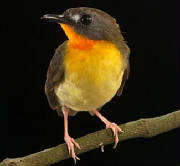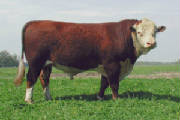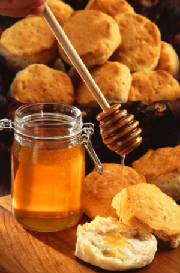|
Meet the Neighbors:
New Species Discovered
By Marc Lallanilla
Pity the modern explorer: All the continents have been mapped, cell phones are found in the most remote regions,
and jet travel has made the world very small indeed. There’s really nothing left to discover, right?
Wrong. Scientists have been celebrating the naming of new species of animals discovered in forested mountain ranges, deep
ocean abysses, tropical islands and other habitats the world over -- even in the urban jungles of New York City.
"It makes us humble about what we know," says Bruce Beehler, Ph.D., senior research scientist with Conservation International, a research and environmental advocacy group based in Arlington, Va. "It reminds us that the Earth is not well known."

|
| Smithsonian Institution |
The discovery of new species, whether insects, birds or mammals, is an important part of wilderness conservation, since
these newly discovered animals can't exist outside the natural world in which they evolved. The identification and cataloging
of new species helps us better understand and protect the habitats they occupy.
"Habitats around the world are changing rapidly; natural systems are being altered, diminished, and lost," says Quentin
Wheeler, director of the International Institute for Species Exploration at Arizona State University in Tempe. "You need to know what's there in order to know what you want to save, as well as to monitor your successes and
failures."
Field biologists are using interesting new tools to identify and catalog new species. Advanced microscopes can now be operated
via remote control by scientists thousands of miles away. DNA analysis allows specimens to be precisely identified. And online
digital images of plants and animals allow naturalists in developing countries access to the same information that was once
available only at prestigious universities. "It's an important step to democratize scientific knowledge," says Wheeler.
Far from being completely documented, the natural world continues to be a source of wonder. "It is estimated that well
fewer than half the Earth's species have been described and named," says Beehler. "These many living species -- known and
unknown -- are the fundamental building blocks of the biosphere. They support the well-being of humankind."
Where Are the
Green Jobs?
Green jobs are the promise of the future,
but are they hiring today?
By Marc Lallanilla
From energy-saving office buildings to hybrid cars, it sometimes seems
the whole world is turning green. Among the many supposed benefits of the environmental movement is the promise of new green
jobs.
Many of these new green jobs will actually be old jobs that have shifted
over to cleaner, greener industries. For example, there are currently about 168,000 sheet metal workers and 386,000 welders
in the United States. Both of these trades will be in increasing demand — and enjoy increased
wages — for building wind turbines, solar equipment and energy-efficient vehicles, according
to the Political Economy Research Institute (PERI).

|
| Wikimedia |
Green Jobs or Green Hype?
But the hype about green-collar jobs can be difficult to separate from
the reality. What exactly is a green job, where are they, and who’s getting them?
It depends on who you ask. A report authored by the U.S. Conference of
Mayors and Global Insight determined that over 750,000 Americans were working in green jobs in 2006. Meanwhile, PERI estimates
that many more — over 14 million people — now work in 45
green occupations. The actual number probably lies somewhere in between.
Forecasts of future employment in the environmental field are also hard
to pin down. One out of every four workers in the United States will be working in the renewable energy or energy efficiency
industries by 2030, trumpets the American Solar Energy Society (ASES). They also optimistically report that these jobs could
generate between $1.9 and $4.5 trillion in annual revenue.
The report from ASES acknowledges, however, that any forecasting data depend
heavily on definitions — and there are no widely accepted definitions of "green collar,"
"alternative energy" or the other phrases bandied about by the environmental movement. Because the terminology is still ill-defined,
the U.S. Department of Labor doesn't keep any records on the growth of green-collar employment, explained Gary Steinberg,
spokesman for the department’s Bureau of Labor Statistics.
For the full article, visit About.com
Antibiotic Resistance
and Your Meat
Why are antibiotics given to
healthy farm animals?
By Marc Lallanilla
Health experts worldwide are alarmed at the reckless use of antibiotics,
and fear their overuse is creating a vast army of "superbug" bacteria with antibiotic resistance. Perhaps the biggest villains
in the overuse of antibiotics are factory farms that raise millions of cattle, pigs, chicken and other livestock.
These farm animals are routinely given a steady supply of antibiotics in
feed supplements and in water, regardless of whether there's evidence of any disease. Estimates vary -- in part because nobody's
keeping any records -- but roughly 50 to 70% of all the antibiotics used in the United States go not to sick people, but to
healthy animals.

|
| Wikimedia |
Antibiotics: When Bigger Is not Better
This "sub-therapeutic" use of antibiotic drugs helps animals grow slightly
larger (about two or three percent bigger). Some farmers argue that the constant use of antibiotics also helps to prevent
diseases that would otherwise spread quickly in the crowded pens that are common on factory farms.
Groups like the American Medical Association, the Union of Concerned Scientists,
and the Infectious Diseases Society of America have condemned the routine use of antibiotics, and are arguing in favor of
legislation that would ban the use of antibiotics in healthy animals. And after many years of debate, the Food and Drug Administration
is preparing to issue voluntary guidelines to limit antibiotic use; these are a step in the right direction, but the FDA guidelines
are toothless recommendations that farmers are free to ignore.
For the complete article, visit About.com
Green Burials:
Thinking Outside the Box
Natural Burials Signal a Return to More Traditional
Funeral Practices
By MARC LALLANILLA

Oct. 14, 2004 -- When Bonnie Ramey buried her husband two years ago, she knew she didn't want to
have a typical funeral ceremony at a landscaped cemetery plot.
"The commercialization of funerals is getting out of control," she said. "They get you at your weakest point. In my opinion,
they're just ripping off the dead."
So after Charles died, Bonnie's choice of burial spots was an easy one — down the road from her house is Memorial
Ecosystems, one of the only places in the United States devoted to environmentally sensitive or "green" burials.

|
| (PhotoDisc) |
The ideas behind green burials are simple. Bodies are not embalmed. Elaborate caskets made of metal or rare tropical hardwoods
are replaced with fabric burial shrouds or simple, biodegradable coffins made of wood or cardboard. Concrete grave liners
or vaults that prevent the ground above the coffin from settling are avoided.
Though there are over 200 green cemeteries in Great Britain, the movement is relatively unknown in the United States. South
Carolina, Florida, California and Texas have the only four green cemeteries currently operating here. Several more green burial
facilities are being planned throughout the country.
For the full story, go to ABC News
|
 |
|
|
|
 |
'Honey laundering':
An international food-safety crisis

|
| USDA |
Before honey ever reaches American breakfasts,
it often comes into contact with dangerous additives — and the FDA isn't doing much about it
By Marc Lallanilla
August 22, 2011 — What could be more pure and natural than honey,
nature's golden sweetener? Plenty, according to a recent investigation by Food Safety News, which has found that
about one-third of the "honey" Americans are consuming isn't honey but a heavily doctored sweetener that contains artificial
sugary concoctions and even dangerous ingredients.
Because honey is added to countless foods — like granola, breakfast
cereals, and cookies — "honey laundering" has become a multimillion-dollar international crime story.
What's being added to honey?
A lot of sugary
compounds, according to researchers. Much of the honey Americans buy is imported from Asia, and it's often nothing but "a
mix of sugar water, malt sweeteners, corn or rice syrup, jaggery [a type of unrefined sugar], barley malt sweetener, or other
additives with a bit of actual honey," says Andrew Schneider in Food Safety News.
Is imported honey dangerous?
Heavy metals like
lead, which causes brain damage and other health problems, have been found in honey that's stored in big containers made of
lead and lead alloys. And experts are alarmed that beekeepers in China are using "an antibiotic that the FDA has banned in
food and that has been linked to DNA damage in children," says Tom Laskawy at Grist.
Is anyone tackling this problem?
The European
Union has banned all honey imports from India, where much of the world's honey laundering takes place. But in the United States,
where domestic honey producers supply only about half of the U.S. demand for the sweet stuff, the FDA has taken a "lackadaisical"
approach to honey imports. Fifteen people in Seattle and Chicago were recently busted for their role in honey laundering,
but the practice continues.
Huge Meat-Eating Dinosaur Discovered
Bigger than T. Rex, This Monster Was Eight Tons of Hungry

|
| (Rodolso Coria) |
By MARC LALLANILLA

April 17, 2006 — Move over, Tyrannosaurus Rex. There's a new dinosaur in town, and he's bigger and badder than you
ever were.
A ferocious meat-eater named Mapusaurus roseae and weighing almost eight tons was recently discovered in Argentina. Because
the bones of several individuals were found in one place, scientists believe that the carnivores lived together in social
units and hunted with deadly efficiency in well-organized packs.
"They would have been quite formidable," said Philip Currie, paleontologist at the University of Alberta who worked on
the Mapusaurus site. "These were definitely the top dogs in the Southern Hemisphere."
The Family that Preys Together
The Mapusaurus bones were found in a bone bed on a hill in the Patagonia region of southern Argentina. "Bone beds are a
good area to work for giving info on more than one animal," said Currie, who made the Mapusaurus discovery with Rodolfo Coria
of the Museo Carmen Funes in Plaza Huincul, Argentina.
Carnivorous dinosaurs like T. Rex were once believed to be solitary hunters, but new evidence suggests otherwise. Currie
speculates that the Mapusaurus he and Coria discovered were all living together in a social group until their death in some
catastrophic event about 100 million years ago.
"They all died together, so you can reason that they all lived together," Currie said. "Carnivores, when you find them
all together like this, were probably packing animals with coordinated hunting efforts."
For the full story, go to ABC News
No Bed of Roses
Floral Industry's Use of Pesticides
Has Some Consumers Wary
By MARC LALLANILLA

Feb. 13, 2004 — Nothing can express affection
on Valentine's Day better than a bouquet of fresh flowers. But those floral beauties come at a high cost — for the health
of the workers that harvest them.
That's because most flowers are grown free from many pesticide regulations,
leaving low-wage floral industry workers vulnerable to toxic exposures.
Now, in part because of growing pressure from consumers, who are beginning
to seek alternatives like organically grown flowers, flower buyers worldwide appear increasingly concerned about the environmental
and health hazards of pesticide use.

About 65 percent of the flowers sold in the United States are imported, primarily
from Colombia and Ecuador. For those nations, blessed by rich volcanic soils, ample sunshine and a mild climate, floriculture
investment has blossomed into a large and profitable industry. Colombia alone exports about $630 million worth of flowers
annually.
And even critics of the flower industry agree the stable jobs and higher-than-average
wages provided by flower growers are a benefit to workers. In recent years, for example, some large commercial growers have
attempted to provide better housing, schools and health care for communities surrounding their farms.
But reports from the field suggest life as a flower farm employee is no bed
of roses.
For the full story, go to ABC News
|
 |
|
|
|

